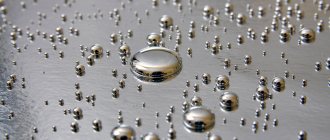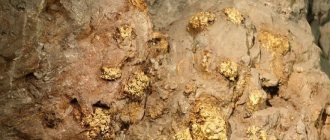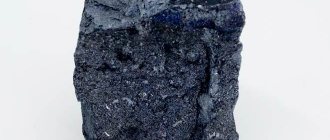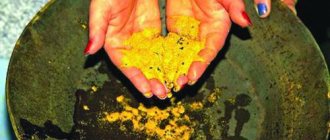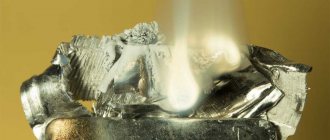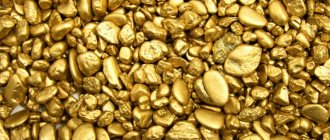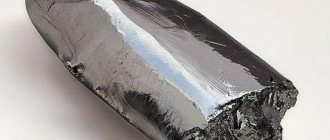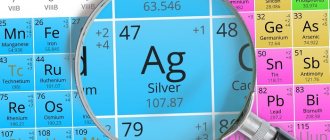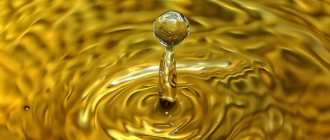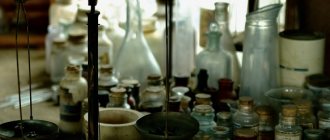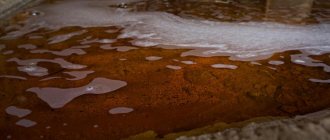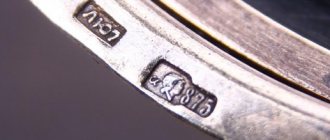h.n. O.V. Mosin GOLDEN WATER
Gold (lat. Aurum), Au is a chemical element of group I of the periodic system of Mendeleev with atomic number 79 and atomic mass 196.9665.
In nature, gold is a heavy yellow metal.
. Consists of only one stable isotope 197Au.
Gold was the first metal known to man. Gold products were found in cultural layers of the Neolithic era (5-4th millennium BC). In ancient states - Egypt, Mesopotamia, India, China, gold mining, the manufacture of jewelry and other items from it existed for 3-2 millennia BC. e.
Gold is often mentioned in the Bible, the Iliad, the Odyssey and other monuments of ancient literature. Alchemists called gold the “king of metals” and designated it with the symbol of the Sun. The discovery of ways to transform base metals into gold was the main goal of alchemy.
Distribution of gold in nature
The average gold content in the earth's crust is 4.3·10-7% by mass. Gold is dispersed in magma and igneous rocks, but hydrothermal gold deposits of important industrial importance (quartz gold-bearing veins, etc.) are formed from hot waters in the earth’s crust. In nature, gold is mainly found in a free (native) state and only very rarely forms minerals with selenium, tellurium, antimony, and bismuth. Pyrite and other sulfides often contain an admixture of gold, which is extracted during the processing of copper, polymetallic and other ores.
In the biosphere, gold migrates in combination with organic compounds and mechanically in river suspensions. One liter of sea and river water contains about 4·10-9 g of gold. In areas of gold deposits, groundwater contains approximately 10-6 g/l of gold. It migrates in the soil and from there gets into plants that concentrate gold - horsetails, corn. The destruction of endogenous gold deposits leads to the formation of gold placers of industrial importance. Gold is mined in 41 countries; its main reserves are concentrated in Russia, South Africa and Canada.
Gold (III) [edit]
Gold(III) complexes are four-coordinate, square, planar, diamagnetic, toxic, with 16 electron species. When the formal coordination number is less than 4, ligands such as chlorine can fill it to form a bridging ligand. Another strategy is intramolecular chelation. In general, gold(III) compounds are toxic and therefore less studied than gold(I). Monoarylgold(III) complexes represent one well-studied class of complexes. They are often prepared by direct electrophilic aurization of arenes with AuCl 3 . [7] Homoleptic tetraalkyl laurate(III) complexes (e.g. Li) are also well characterized. [8]
Physical properties of gold
Gold is a soft, very ductile, malleable metal.
(can be forged into sheets up to 8·10-5 mm thick, stretched into wire, 2 km of which weigh 1 g), conducts heat and electricity well, and is very resistant to chemical influences. The crystal lattice of Gold is face-centered cubic, a = 4.704 Å. Atomic radius 1.44 Å, ionic radius Au1+ 1.37 Å. Density (at 20°C) 19.32 g/cm3, melting point 1064.43°C, boiling point 2947°C; thermal coefficient of linear expansion 14.2·10-6 (0-100 °C); specific thermal conductivity 311.48 W/(m K) [0.744 cal/(cm sec °C)]; specific heat capacity 132.3 J/(kg K) [0.0316 cal/(g °C)] (at 0°-100 °C); electrical resistivity 2.25·10-8 ohm·m (2.25·10-6 ohm·cm) (at 20 °C); temperature coefficient of electrical resistance 0.00396 (0-100 °C). The Brinell hardness of gold is 180 Mn/m2 (18 kgf/mm2) (for annealed gold about 400 °C).
The place of gold in the periodic table of Mendeleev and its general properties
What are the properties of gold? In the brainchild of the Russian genius, the precious metal occupies number 79, and is designated as Au. Au is short for its Latin name Aurum, which translates to “shining.” It is located in the 6th period of the 11th group, in the 9th row.
The electronic formula of gold, which is the reason for the valuable properties of gold, is 4f14 5d10 6s1, all this suggests that gold atoms have a significant molar mass, large weight and are inert in themselves. Only 5d106s1 belong to the outer electrons of such a structure.
And it is the inertness of gold that is its most valuable property. Because of this, gold resists acids very well, almost never oxidizes, and is incredibly rare as an oxidizing agent.
Therefore, it refers to the so-called. "noble" metals. “Noble” metals and gases in chemistry are elements that do not react with almost anything under normal conditions.
Gold can safely be called the most noble metal, since it stands to the right of all its brothers in the series of voltages.
Chemical properties of gold
Gold is the most inert metal, standing in the series of stresses to the right of all other metals; under normal conditions, it does not react with most acids and does not form oxides, which is why it was classified as a noble metal.
in contrast to ordinary metals, which are easily destroyed by the environment. Then the ability of aqua regia to dissolve gold was discovered, which shook confidence in its inertness.
Of the pure acids, gold dissolves only in hot concentrated selenic acid:
2Au + 6H2SeO4 = Au2(SeO4)3 + 3H2SeO3 + 3H2O
Gold reacts relatively easily with oxygen and other oxidizing agents with the participation of complexing agents.
Thus, in aqueous solutions of cyanides with access to oxygen, gold dissolves, forming cyanoaurates:
4Au + 8CN− + 2H2O + O2 → 4[Au(CN)2]− + 4 OH−
In the case of a reaction with chlorine, the possibility of complex formation also significantly facilitates the course of the reaction: if gold reacts with dry chlorine at ~200 °C to form gold(III) chloride, then in an aqueous solution (regia vodka) gold dissolves with the formation of chloraurate ion already at room temperature temperature:
2Au + 3Cl2 + 2Cl− → 2[AuCl4]−
Gold easily reacts with liquid bromine and its solutions in water and organic solvents, giving tribromide AuBr3.
Gold reacts with fluorine in the temperature range 300−400°C; at lower temperatures the reaction does not occur, and at higher temperatures gold fluorides decompose.
Gold also dissolves in mercury, effectively forming a low-melting alloy (amalgam).
In concentrated sulfuric acid, gold dissolves in the presence of oxidizing agents: periodic acid, nitric acid, manganese dioxide. In aqueous solutions of cyanides with access to oxygen, gold dissolves to form very strong dicyanoaurates:
4Au + 8NaCN + 2H2O + O2 → 4Na[Au(CN)2] + 4NaOH
This reaction underlies an important industrial method for extracting gold from ores.
But the most unusual properties are the properties of finely crushed gold. When gold is reduced from highly dilute solutions, it does not precipitate, but forms intensely colored colloidal solutions - hydrosols, which can be purple-red, blue, violet, brown and even black. Thus, when a reducing agent (for example, a 0.005% solution of hydrazine hydrochloride) is added to a 0.0075% solution of H[AuCl4], a transparent blue gold sol is formed, and if 0.005 is added to a 0.0025% solution of H[AuCl4] % solution of potassium carbonate, and then add tannin solution drop by drop while heating, a red transparent sol is formed. Thus, depending on the degree of dispersion, the color of gold changes from blue (coarsely dispersed sol) to red (finely dispersed sol). When the sol particle size is 40 nm, the maximum of its optical absorption occurs at 510–520 nm (red solution), and when the particle size increases to 86 nm, the maximum shifts to 620–630 nm (blue solution). The reduction reaction to form colloidal particles is used in analytical chemistry for the detection of small quantities of gold.
Organic compounds of gold are also known to science.
Thus, the action of gold(III) chloride on aromatic compounds produces compounds that are resistant to water, oxygen and acids, for example: AuCl3 + C6H6 C6H5AuCl2 + HCl. Organic derivatives of gold (I) are stable only in the presence of ligands coordinated with gold, for example, triethylphosphine: CH3Au·P(C2H5)3.
Techemy
Distribution of gold in nature. Gold is found mainly in the form of nuggets. In 1872, a piece of native gold weighing 250 kg was found in Australia. Ore or vein gold is found in primary deposits, and placer or wash gold is found in secondary deposits (river sand). In the water of the world's oceans, the concentration of gold is estimated at 4-10 mg/t. water, i.e. The reserve of gold in the entire mass of ocean water is approximately 10,000,000,000 tons of metal. Industrial gold mining from seawater is not profitable. However, in experimental work, it was possible to obtain metallic gold from sea water by depositing it on ion-exchange resins, followed by leaching and precipitation. Gold is contained not only in the form of native metal, but also in various ores, as well as in the form of soluble complex compounds with hydrogen sulfide contained in deep geothermal waters. There are known cases when a thin layer of gold was found on the casing pipes of geothermal power plants, which is deposited as a result of the decomposition of complex gold compounds when rising to the surface.
Getting gold. 1. Washing of rock containing gold. 2. Extraction from the rock using the amalgam method. The process is based on the property of mercury to dissolve gold to form an amalgam. After dissolving the gold, the amalgam is filtered to remove various insoluble impurities (sand, oxides, etc.). When heated, the mercury is easily driven off, but the gold remains. The resulting gold may contain impurities of copper, silver and other metals that can form amalgams with mercury. In addition, this method of obtaining gold is extremely hazardous to health due to the high toxicity of mercury vapor. 3. Extraction from rock using cyanide method. The rock is treated with a solution of sodium cyanide while blowing with oxygen (air), while the gold goes into solution in the form of a complex salt:
4Au + 8NaCN + 2H2O + O2 = 4Na[Au(CN)2] + 4NaOH
Gold is precipitated from solution using zinc dust
2[Au(CN)2]— + Zn = [Zn(CN)4]2- + 2Au
then treated with dilute sulfuric acid to separate the zinc, washed, dried and purified by the electrolytic method, the electrolyte being H[AuCl4] + HCl.
Physical properties of gold. Gold melting point: 1063*C; Density of gold at 20*C: 19.32 g/cm3. Yellow soft shiny metal with very good electrical and thermal conductivity. The most malleable and ductile metal: 1 g of gold can be drawn into a thread 3240 m long and a gold plate measuring 1 x 1 cm and 0.5 mm thick. can be flattened to a size of 4 square meters.
Chemical properties of gold. Gold is absolutely stable in air. Reacts with chlorine, bromine, and aqua regia (alchemists called gold the king of metals, therefore, a mixture of acids that dissolved gold was given the name “Aqua Regia”) to form a complex compound soluble in water—chlorauric acid:
Au + HNO3 + 4HCl = H[AuCl4] + NO + 2H2O
Application. Gold is a jewelry metal. Gold bars provide paper money. It is also used in denture practice, for dyeing porcelain and glass, embossing on books, making electrical contacts in microelectronics, obtaining gold compounds and gilding. Gilding - covering products with a thin layer of gold; is carried out by foil rolling or by the electroplating method using an electrolyte containing potassium dicyanoaurate(I) and potassium cyanide, and gold plating can also be carried out using an autocatalytic chemical reaction. Experiments are being carried out and the development of a safe technology, Chemical gilding , which will make it possible to chemically apply a thin decorative layer of gold to the prepared surface of plastic, ceramic, glass and other products.
Recently, with the development of nanotechnology, gold is used as a catalyst for various chemical processes, for example: Catalytic oxidation of alcohols and aldehydes into esters. In jewelry, alloys of gold with silver and copper are most often used, due to the softness of pure gold and low wear resistance. The fineness of gold is estimated based on 1000 units - pure, “red” gold, which corresponds to 24 carats (a carat was a previously used measure of the mass of precious stones); Thus, gold standard 333 corresponds to 8 carats.
Gold compounds
Gold(III) compounds are significantly more stable than gold(I) compounds. Gold forms two oxides - gold (I) oxide, or gold oxide, Au2O, and gold (III) oxide, or gold oxide, Au2O3. In aqueous solution, gold always forms complex compounds. From gold-containing solutions, the action of tin (II) chloride can produce an intensely dark red colloidal solution of gold (Cassian gold purple); Gold compounds take on a similar color when heated.
Potassium dicyanoaurate(I) K[Au(CN)2] - colorless crystals with a hexagonal crystal lattice. Density 3.45 g/cm3. Stable in air, decomposes when heated. Solubility in water is 14.3 g per 100 g at 20*C, slightly soluble in ethanol, acetone and ether. It crystallizes from an aqueous solution when alcohol or acids are added. When Zn, Al, Mn, Mg, and other reducing agents act on aqueous solutions of potassium dicyanoaurate(I), Au is released; when heated with dilute acids, AuCN is formed. Potassium dicyanoaurate(I) is easily oxidized by halogens to form K[Au(CN)2X2], where X is Cl, Br or I. Potassium dicyanoaurate(I) is prepared by reacting Au with a KCN solution in the presence of H2O2 or O2, or by reacting AuCN with a KCN solution , anodic dissolution of Au in a KCN solution. Find out more about how to synthesize potassium dicyanoaurate(I) on our chemical forum. Potassium dicyanoaurate(I) is an intermediate product in the extraction of gold from ores. It is used for electrolytic gilding of metal surfaces and elements of microelectronic circuits, as a reagent for the analysis of proteins and enzymes. Toxic. Causes dermatitis and stomatitis, damages the kidneys and brain (!).
Hydrogen tetrachloroaurate(III) ( tetrachlorauric or hydrochlorauric acid ) H[AuCl4] - light yellow, hygroscopic needle-shaped crystals corresponding to the chemical composition H[AuCl4]*4H2O. If tetrachlorauric acid is heated carefully, it decomposes to release HCl and reddish brown crystals of gold(III) chloride AuCl3 . In solution, gold(III) chloride is yellow in color (see photo). The most famous salt of this acid is the “ Golden Salt ” sodium tetrachloroaurate(III) Na[AuCl4] , which is yellow crystals. Alkalies precipitate brown gold (III) hydroxide Au(OH)3 , also called “ Golden acid ”, because this substance has mild acidic properties and forms salts. At 100*C, golden acid loses water, turning into brown gold (III) oxide Au2O3 .
Gold resinate is a reaction product between sulfur-containing essential pine oil (“ Sulfur Balsam ”) and potassium tetrachloroaurate(III) ; This product, when applied to porcelain, leaves a layer of gold after firing with excellent adhesion to the porcelain.
Gold (I) chloride AuCl is a white, slightly soluble substance in water. It is obtained by heating gold(III) chloride in a stream of carbon dioxide to 180*C. oxide Au2O is precipitated from alkali solutions .
All gold compounds easily decompose when heated, releasing metallic gold. Many organic substances (aldehydes, some alcohols, glucose), as well as metal ions in lower oxidation states (Sn2+, Fe2+, etc.) reduce gold to metal from solutions of its salts.
More detailed information about gold and its compounds can be found in the book Refining Gold, Silver and Platinum Group Metals. O.E. Zvyagintsev, 1945
Getting gold
Gold can be extracted from placer deposits by flotation (precipitation), based on the large difference in densities of gold and waste rock. Gold is almost 20 times heavier than water and about 8 times heavier than sand,
Therefore, grains of gold can be separated from sand or crushed waste rock with a stream of water. The ancient method of washing using sheep skins, on which gold grains were deposited, is reflected in the ancient Greek myth of the Golden Fleece. Nuggets and placers of gold were often found along rivers, which eroded gold-bearing rocks for thousands of years. In ancient times, gold was mined only from placers. And now, where they remain, gold-bearing sand is scooped up from the bottom of rivers and lakes and enriched in dredges - huge structures the size of a multi-story building, capable of processing millions of tons of gold-bearing rock per year.
However, this method, which was already used in ancient times, is associated with great losses. It gave way to amalgamation (known already in the 1st century BC and used in America from the 16th century) and cyanidation, which became widespread in America, Africa and Australia in the 1890s.
The old (so-called mercury) method of extracting gold from ore - amalgamation is based on the fact that mercury wets gold well - like water wets glass. Finely ground gold-bearing rock was shaken in barrels with mercury at the bottom. At the same time, gold particles stuck to the liquid metal, being wetted by mercury from all sides. Because the color of the gold particles disappears, the gold may appear to have “dissolved.” The mercury was then separated from the gangue rock and heated to high temperatures. The volatile mercury was distilled off, but the gold remained unchanged. The disadvantages of this method are the high toxicity of mercury and the incomplete extraction of gold: the smallest particles are poorly wetted by mercury.
At the end of the 19th and beginning of the 20th centuries, indigenous deposits became the main source of gold. Gold-bearing rock is crushed and leached with sodium cyanide, in which even the smallest grains are converted into water-soluble cyanide compounds. Then gold is extracted from an aqueous solution using zinc powder: 2Na[Au(CN)2] + Zn → Na[Zn(CN)4] + 2Au. Leaching makes it possible to extract the remaining gold from the dumps of abandoned mines, essentially turning them into a new deposit. The method of underground leaching is also promising: a cyanide solution is pumped into wells, it penetrates through cracks into the rock, where it dissolves gold, after which the solution is pumped out through other wells.
Another method of purifying gold by electrolysis was proposed by E. Wohlwill in 1896. Anodes cast from impure gold are suspended in a bath containing a hydrochloric acid solution of AuCl3; a sheet of pure gold serves as the cathode. In this case, when a current passes, impurities precipitate (anodic sludge, sludge), and gold with a purity of at least 99.99% is deposited on the cathode.
Gold-catalyzed reactions[edit]
Although gold is not commercially important, it catalyzes many organic transformations, typically carbon-carbon bond formation from Au(I) and CX bond formation (X=O,N) from the Au(III) state due to the more severe Lewis acidity of this ion . . During the last decade, several studies have demonstrated that gold can efficiently catalyze the cross-coupling reactions of CC and C heteroatoms that proceed through the Au(I)/Au(III) cycle. [29] Hong S. Shen summarized homogeneous reactions to form cyclic compounds into 4 main categories: [30]
- nucleophilic addition of a heteroatom to unsaturated CC bonds, especially with the formation of small heterocycles (furans, pyrroles, thiophenes)
- Hydroarylation: Basically a Friedel-Crafts reaction using metal-alkyne complexes. Example of the reaction of mesitylene with phenylacetylene: [31]
- Cyclization of enyne, in particular cycloisomerization, one of the first examples is the cycloisomerization of 5-exo-dig 1,6 enyne: [32]
- cycloaddition reactions with an early example of the cycloaddition of a nitrile oxide to an alkyne. [33]
Other reactions include the use of gold in the activation of the C–H bond [34] and aldol reactions. Gold also catalyzes coupling reactions. [35]
Restrictions [edit]
While gold-catalyzed hydrofunctionalization of alkynes, allenes, and allylic alcohols [36] occurs readily under relatively mild conditions, the unactivated alkene remains a poor substrate in most cases [37], due in large part to the stability of intermediate alkylgold(I) complexes. before protodeuration. [38] The development of intermolecular transformations catalyzed by gold also lags behind the development of intramolecular ones. [39]
Trivalent gold oxide
Another binary gold compound consists of two Au atoms and three oxygen atoms, which can be written: Au2O3. It is a hard brown substance that breaks down easily even when exposed to sunlight. Gold(III) oxide cannot be dissolved in water, but it dissolves well in potassium hydroxide, forming a complex compound. It is obtained by drying gold hydroxide over phosphorus oxide vapor and further heating the mixture to 140 degrees. Maintaining the correct temperature regime is critically important, because if the reagents are heated an additional 20 degrees, then instead of dehydration of the hydroxide and crystallization of the oxide, decomposition of the resulting mixture will occur.
Based on the chemical properties of the substance, it is also called golden acid, because Au2O3 can form salts called aurates. Due to its properties, gold(III) oxide has found its application in technology. It was from this that “gold tracks” were made on microelectronic circuit boards by depositing a layer of the substance on the surface and then exposing it to a laser to obtain a thin strip of noble metal.
There is another substance that can be classified as gold oxides. This is a compound in which atoms with valences I and III are present simultaneously. Essentially a mixture of both oxides, the substance exists as a brown powder that is highly absorbent.
What all gold oxides have in common is that they find almost no application in technology or any other industry. The reason for this, apparently, is that these compounds are unstable in environmental conditions and are easily destroyed, turning into other substances. And also do not forget about the high price of gold itself, not to mention the additional costs of the reactions necessary to make it oxidize. Therefore, now mainly theoretical chemists deal with gold oxides, conducting many experiments with them. But it may well be that they will soon be crowned with success, and materials based on gold oxide will help make another technological breakthrough.
Source
Gold(I,III) oxide
| Gold(I,III) oxide | |
| Are common | |
| Systematic name | Gold(I,III) oxide |
| Traditional names | Gold oxide; awrah of gold |
| Chemical formula | Au[AuO2] |
| Rational formula | AuO |
| Physical properties | |
| Condition (standard condition) | brown powder |
| Molar mass | 425.93 g/mol |
Gold(I,III) oxide
- inorganic compound, gold metal oxide with the formula Au[AuO2], can be considered as gold aurat salt or mixed oxide Au2O•Au2O3, brown powder.
Receipt
Obtained from gold(III) hydroxide Au2O3 x
H2O by dehydration by heating. Complete loss of water occurs at a temperature of about 200 o C. [1]. The gold(III) oxide thus obtained is amorphous. It has a red or red-brown color. The brown impurity, as in the case of gold(III) hydroxide, is usually associated with the presence of a small amount of gold(0). Au2O3 single crystals were obtained from an amorphous oxide by hydrothermal synthesis in a quartz ampoule filled one-third with a mixture of perchloric acid HClO4 and alkali metal perchlorate (synthesis temperature 235-275 o C, pressure up to 30 MPa). The resulting single crystals had a ruby red color [1].
applications
Coloring glasses
One of the most prominent uses is to impart reddish colors to certain materials such as glasses, in addition to imparting certain properties inherent to gold atoms.
Synthesis of aurat and lightning gold
Additionally, Au2O3 reacts with ammonia to form the lightning-fast gold compound, Au2O3(NH3)4. Its name comes from the fact that it is highly explosive.
Processing of self-assembled monolayers
Regarding gold and its oxide, some compounds such as dialkyl disulfides, RSSR, do not adsorb equally. When this adsorption occurs, an Au-S bond is spontaneously formed, where the sulfur atom exhibits and determines the chemical characteristics of the said surface depending on the functional group with which it is bonded.
RSSR cannot be adsorbed on Au2O3 but on gold metal. Therefore, if the surface of gold and its oxidation state are modified, as well as the size of Au2O3 particles or layers, a more heterogeneous surface can be developed.
This Au2O3-AuSR surface interacts with the metal oxides of some electronic devices, thereby creating smarter surfaces in the future.
Source
Gold oxide (I)
It is a binary compound, that is, consisting of only two types of atoms, with the chemical formula Au2O. It is a gray-violet powder or a blue hydrosol. It does not dissolve in water, but exposure to a humid environment leads to its transformation into another substance. If you heat gold oxide to about 200 degrees Celsius, it will decompose into its constituent elements. Low thermal resistance is due to the fact that gold ions have oxidizing ability and strong polarizing effects.
It is difficult to obtain monovalent gold oxide, because gold oxidizes very poorly. Given the fact that gold is a very inert element, a simple reaction with oxygen, even at high temperatures, will not result in the formation of an oxide, as happens with most other easily oxidized metals. Even passing an electric current through a gold electrode, you still cannot obtain an oxide film on its surface. In order to synthesize gold oxide, a two-step procedure is used. First, gold chloride is added to a cold aqueous alkali solution and then the resulting mixture is gradually heated.
As for the chemical properties of this substance, it is capable of reacting with concentrated ammonium hydroxide. In this case, a complex inorganic compound is formed in the form of a black precipitate, which has the ability to explode upon impact.
Oxides and their properties
Gold oxide does not form in nature; the elements with which this metal combines can be counted on one hand. There are very few of them. If we talk about pure gold, then oxygen does not destroy it, the same can be said about water and a large number of other reagents.
Chemical element gold
Gold oxidizes only when interacting with the following elements:
If we talk about mercury, then when the elements interact, an alloy is formed, which chemists call an amalgam.
A mixture of nitric and hydrochloric acids in a ratio of 1 to 3 is called aqua regia; when immersed in this mixture, the metal begins to dissolve. As the temperature rises, the reaction speeds up.
Selenic acid in high concentration can oxidize gold; such technology is used only in industry to extract the noble element from rock.
Chlorine and bromine can react with Au, the presence of chlorine in the reaction speeds up the process. For this reason, it is not recommended to wear gold jewelry while cleaning, as it may be damaged.
Gold oxide has several varieties, and there is also hydroxide, which is a mixture of gold, oxygen and hydrogen. To put it simply, it is a mixture of water and a noble metal. But since the metal is inert, it is not so easy to obtain such a mixture.
Pure gold can only oxidize under certain circumstances. To do this, it is necessary to maintain the temperature regime and comply with the conditions.
Gold oxide comes in only two varieties; you can determine which chemical element we are talking about using the designation. Chemists complete the names of substances with Roman numerals I and III.
The element is an inorganic compound, an oxide of metal and oxygen, considered as an aurat salt or a mixed oxide. It is a brown powder.
Gold oxide can be obtained in several ways, but oxygen must participate in the reaction.
The compound of water and Au numbered I is obtained by heating an element with the same name, but numbered III. And to obtain an oxide you will need a hydroxide, that is, a compound of a metal with water.
Chemical compound Au2O3
The reaction takes place in a quartz ampoule, which should be one-third filled with perchloric acid, at a temperature of 200 degrees. Water is evaporated from the compound by increasing the temperature, resulting in a red or brown powder. A brown tint indicates either the low quality of the metal or its low content.
As the temperature increases, crystals can be obtained that will have a ruby hue. The readings should be approximately 240–270 degrees.
You can characterize compound number III with the following properties:
Crystals connect to each other like a bridge, that is, one molecule connects two, two molecules connect three, and thus in an ascending manner.
It can be noted that the oxide has a certain similarity with the metal; for example, the element also dissolves rapidly in hydrochloric and nitric acids.
What can element number I do and what properties does it have:
The element is obtained by heating; potassium hydroxide and gold chloride are needed to carry out the reaction.
The compound quickly returns to its original state, for this reason the element is considered as a powder, which may have a purple tint. As the temperature increases, the compound decomposes.
If you add ammonium hydroxide, or, more simply, ammonia, to the compound, a black precipitate is formed during the reaction. If subjected to force (from an impact), the connection may explode.
The compound with the chemical formula 3Au2O·4NH3 is not stable, disintegrates in hot water, and does not form a precipitate.
Where can the procedure be performed?
- Gold refining is carried out by specialized enterprises. In Russia, these are Uralelectromed JSC, Kolyma Refinery and several other organizations. The main method of purifying metal from impurities on an industrial scale is electrolytic (separation of the melt into its component parts by passing an electric current through it).
- There are laboratories with the necessary equipment and hood.
- Some refining techniques can be reproduced at home if you take care of the materials and tools.
properties
Appearance
It is a reddish-brown solid.
Molecular mass
density
Melting point
Melts and decomposes at 160ºC. Therefore, it lacks the boiling point, so this oxide never reaches the boiling point.
stability
Au2O3 is thermodynamically unstable because, as mentioned at the beginning, gold does not tend to oxidize under normal temperature conditions. So it can be easily reduced to become noble gold again.
The higher the temperature, the faster the reaction, known as thermal decomposition, occurs. So, Au2O3 at 160 °C it decomposes, forming metallic gold and releasing molecular oxygen:
A very similar reaction can occur with other compounds that promote this reduction. Why the reduction? Because gold comes back to get the electrons that oxygen took from it; this is the same as saying that it loses its connection with oxygen.
solubility
It is a solid substance, insoluble in water. However, it is soluble in hydrochloric acid and nitric acid due to the formation of gold chlorides and nitrates.
Gold refining methods
Methods for purifying precious metals are divided into:
- chemical (based on the interaction of substances, there are dry and wet);
- electrochemical (electrolysis).
Dry
When talking about the dry method of gold purification, they mean the Miller method. It is used only in industrial conditions due to the toxicity and corrosiveness of chlorine and its compounds, which are released in excess during the reaction.
The essence of the method: chlorine gas is passed through the crushed mass of the processed substance. Compounds of base metals with chlorine are volatile and are removed from the alloy, increasing the gold purity.
Miller's method is effective due to the fact that noble metals react with chlorine last (zinc and iron are removed first, gold and platinum are removed last). Its advantages:
- it is inexpensive;
- does not require large areas to accommodate equipment;
- short - takes several hours;
- removes almost all alloy, increasing the gold content in the alloy to 99.5–99.9%.
The refining process takes place in a crucible (a refractory melting tank), into which chlorine enters through a pipe. Excess components are removed from the mixture, and silver chloride rises to the surface of the alloy - this makes it possible to further separate the noble metals from each other. Miller's method helps to obtain gold from both a multicomponent alloy and an alloy with silver.
Wet
It is convenient to separate the noble metal from the alloy by dissolving either the metal itself or impurities.
The most popular refining method involves reacting scrap with aqua regia (a mixture of nitric and hydrochloric acids - one of the few compounds that dissolves gold). The solution is evaporated and the gold is precipitated using iron sulfate (also suitable for reduction from chloride), oxalic acid, sodium pyrosulfite or hydrazine.
If the reduction reaction is carried out correctly, the loss of pure substance at the output will be minimal, and the sample will reach 999.
There is a way to dissolve gold using Lugol's solution - a combination of potassium and iodine.
Quarting is also used (from the Latin quarta - fourth) - alloying gold in a ratio of 1:3 with another metal (brass, zinc, copper), which is subsequently dissolved in nitric acid. Impurities will not dissolve qualitatively if their content is less than ¾ of the volume, so the semi-finished product is quartted. Theoretically, you can try this at home, but be aware that when dissolved, it releases very poisonous nitric oxide.
If you have gold in solution, it can be easily refined with stannous chloride powder. A day after the start of the process, the gold will settle to the bottom of the container in which you left it. The good thing about the method with tin chloride is that when using it, the operator’s body is not endangered, as when working with volatile chlorides or acid.
Electrolytic
Electrolysis involves the separation of the constituent components of the alloy on the electrodes as a result of the passage of electric current through the electrolyte. During refining, the anode (electrode with a positive potential) is a gold-containing alloy, and the cathode (electrode with a negative potential) is thin rolled gold (999) tin. An electrolyte is a solution of gold chloride and an acid that dissolves the anode.
The initial anode sample is at least 900. The process takes place in small porcelain baths (
25 l), installed in water baths to maintain a temperature of 50–60 °C. Gold particles settle in layers on the cathode. After the process is completed, the anode sludge is sent for further processing: the silver is separated and melted into anodes for silver electrolysis.
What methods of affining can be carried out at home?
Of course, you cannot conduct an experiment with chlorine at home. But you can try to extract gold from scrap or computer waste using tin chloride and acids. Skilled alchemists can use the electrolytic method. But don't forget about safety precautions!
The process of refining gold at home
If you decide to conduct the experiment at home, you need to prepare. First of all, think about safety precautions: you will need a mask to protect against fumes, gloves and caution. You can experiment only in a well-ventilated area, where children and animals do not have access.
Necessary raw materials, equipment and reagents
Let's imagine that we were able to get everything we needed for work and decided to try. Let's get started with quartering: let's bring the gold sample to 200-250, diluting the starting material with copper, and then dissolve the alloy. Zinc would dissolve faster than copper, but the alloy with it is very fragile, and copper is easier to control for a beginner.
For refining we will need:
- gold scrap, the standard of which will be increased;
- two crucibles (you can buy them or make them yourself from fireclay clay and fire them);
- 999 fine copper (it is convenient to buy granulated copper at the rate of N×3–m, where N is the approximate mass of gold in our scrap, and m is the approximate mass of the alloy);
- nitric acid (also sold, its amount should be 10 times the total amount of metal);
- hydrochloric acid;
- borax (antiseptic sodium tetraborate, available at the pharmacy);
- melting burner;
- a wooden (birch, aspen) stick for stirring the melt (some jewelers recommend using graphite pencil rods);
- long tweezers;
- gauze;
- a cap with a hole for covering the crucible;
- electric stove;
- glass fireproof flask for boiling.
Preparation
Let's say we have 20 g of 585-carat jewelry gold, that is, 11.7 g of pure metal and 8.3 g of impurities are alloyed. For quartering you will need copper in the amount of 26.8 g (11.7 × 3–8.3).
- We chop the scrap - for example, using wire cutters.
- We dry and heat the crucibles, otherwise there is a risk that they will burst.
- Add copper granules to the original gold with tweezers and stir until it melts evenly, without stopping heating. We take each new piece after the previous one has melted.
- We roll out or granulate the mass by pouring it into water in a thin stream (the zinc alloy can be crushed even in a mortar).
Affination process
Important: this part of the process is carried out only in fresh air, otherwise it is life-threatening! The ideal option is a summer cottage that has an extension cord to connect to the electric stove.
Add 60–70 ml of nitric acid to the flask with crushed metal. As the reaction subsides, add another 40–50 ml so that the interaction resumes (the total volume of acid should not exceed 200 ml). We repeat the procedure 2-3 times, after which we bring the flask to a boil.
We wash the precipitate with clean water, adding it to the flask until the mixture becomes transparent, and carefully draining it. Then, with a small amount of water, sprinkled generously with borax, we place the gold in a clean crucible (it’s convenient to use gauze for this - you’ll get a “knot” of gold flakes).
The crucible with wrapped gold, sprinkled with borax, covered with a cap, is kept on the fire until the gauze wears out. Having made sure that the mixture of borax and gold has become more or less homogeneous, we proceed to melting. Sprinkle the molten metal with borax again.
The refining process can be considered complete when the gold that begins to harden does not become cloudy, but remains shiny. Until this happens, we continue to melt it and sprinkle it with borax.
Pure gold melts very beautifully. You can see how professional jewelers melt it in the video:
